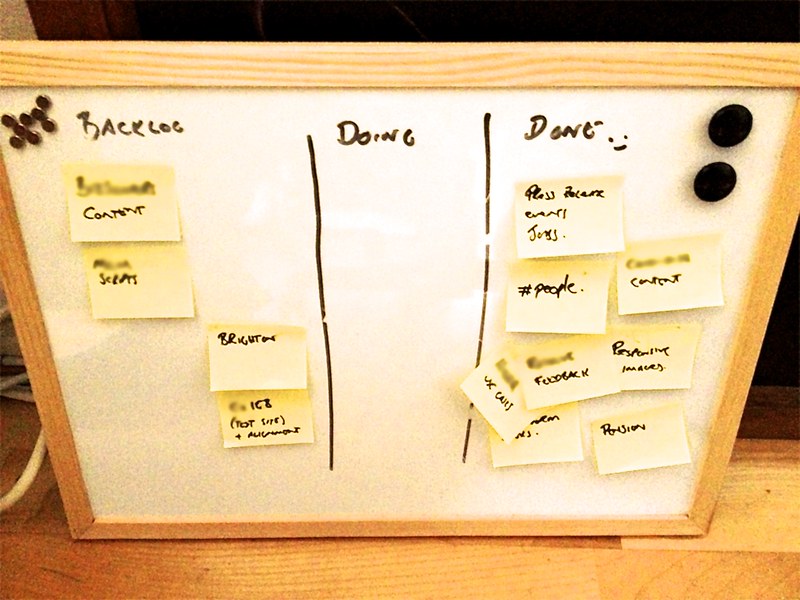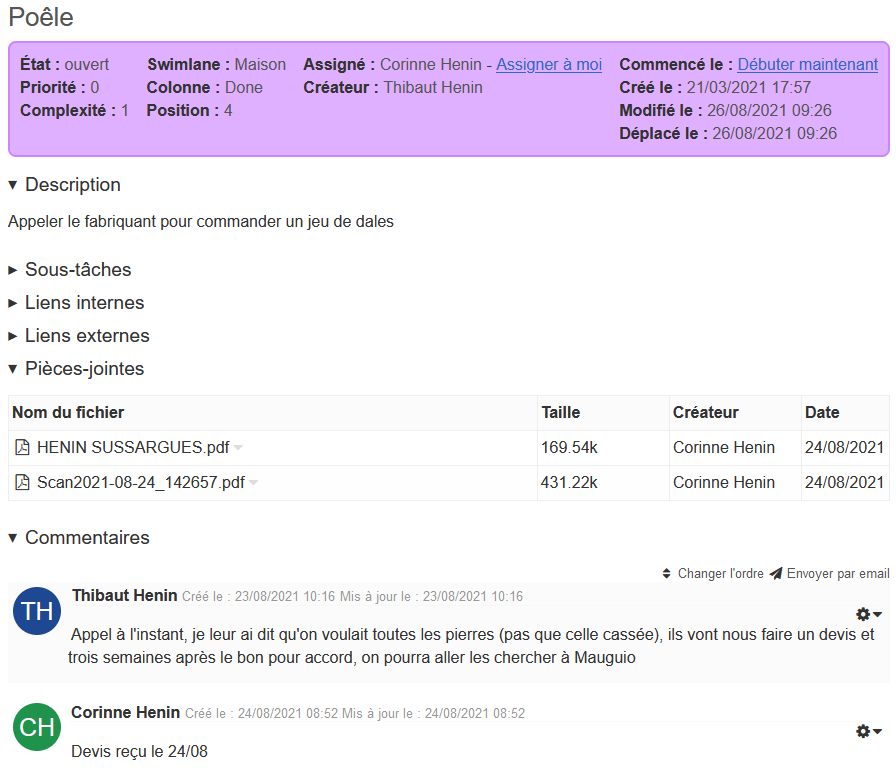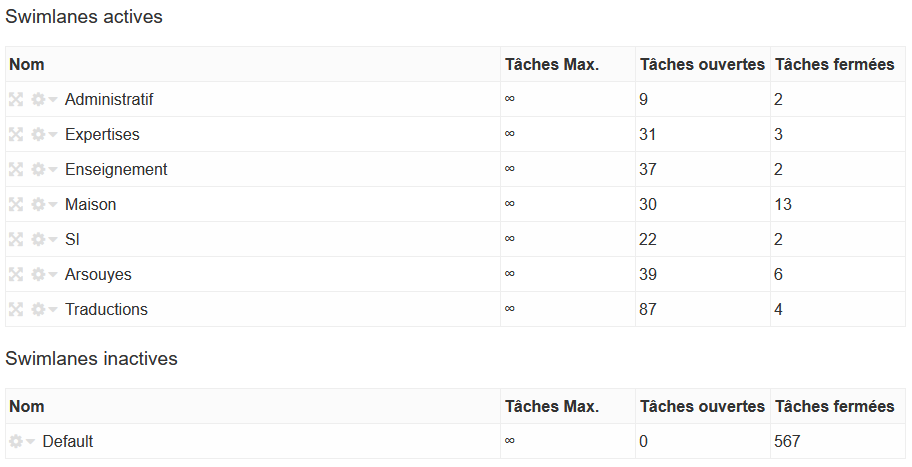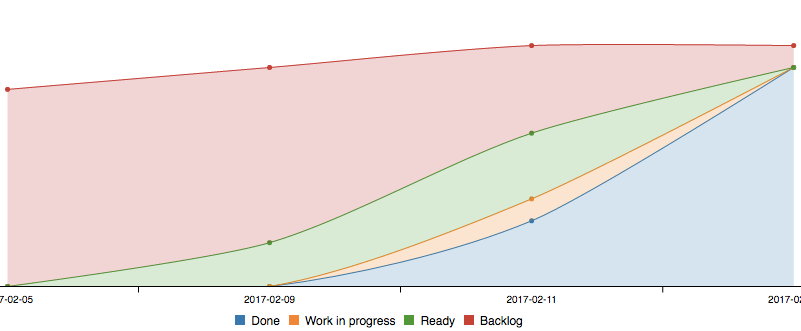Reduce mental load
Spoiler: The arsouyes ares also the story of a family. We created the site shortly after we began our relationship and since then we have come a long way. Among other things on the distribution of tasks (professional, domestic and parental) and we thought it would be worthwhile to share our findings with you. To reverse the spiral, we combined several management methods (Gordon, Getting Things Done and Kanban) and we implemented all of this via the kanboard application.
Some time ago, it was simple. We knew who was in charge and had to do what. The machine was working and those with the power saw no reason to change.
Then we realized that it was neither fair nor efficient and we invented horizontal work organizations. To rebalance relations, we banished ancestral roles and blew up the hierarchical pyramids (or rather the middle floors, do not expect more).
And to avoid difficult changes or realizing that nothing has indeed changed, we carefully avoid addressing the only issue that matters:
Who is responsible for what?

For example, laws have been gradually changed to smooth out family structures. Among other things, since 1970 in France, paternal power has been replaced by parental authority (held by both parents, cf. Art. 371-1 of civil code) 🎉.
On the other hand, when we look at “who does what”, we realize that in 2010, a quarter of men still did no domestic tasks and half share no time with their children. On average, men only take care of a third of the couple’s tasks (cf. Domestic and parental tasks of men and women, INSEE). Is it still equality?
And that’s without counting the mental load of organizing all these tasks. Plan and remember what needs to be done, when and by whom. Including the management of providers for everything that will be delegated… In far too many cases, it is the women who also take care of it.
Businesses are not immune to this problem. As a result of resigning leaders or poorly controlled hierarchical flattening, when a team is left free-wheeling, the same problems arise: many boring tasks are left to “the first who crack”.
In any case, we create a habit that will be as difficult to change as [a Nash equilibrium] (https://en.wikipedia.org/wiki/Nash_equilibrium): as long as the winners do not change their strategy, the losers are afraid of making the situation worse by stopping their efforts…
Management methods
Before showing you how we do it in practice, we thought it would be relevant to tell you more about our sources of inspiration. In order that you understand the why and how and if you want to adapt it will be easier.
Gordon Method
The first inspiration comes from the work of psychologist Thomas Gordon in his search for conflict resolution (the famous “Gordon Method”). He has explained it and declined in several very interesting books, but for the problem that interests us today, here are the main ideas.

- Who owns the problem? When faced with a problem, we must distinguish between those that concern us (and that we will seek to resolve) and those that do not concern us (and that we abandon the initiative of the resolution).
- Solving without losing. Once a problem has been expressed, we look together for solutions that meet everyone’s needs. In order to make everyone’s positions clear, each one expresses himself by “I-messages” (the subject is myself, not the others) and reformulates what he heard to be sure to have understood it correctly (called active listening).
Of course, sometimes you have to do more than one “loop” to solve a problem. The solutions proposed are not always acceptable; upfront, after trying them or because the situation has changed. We must then find a new solution and so on.
All that remains is to put these solutions in place; organize and perform all these necessary tasks. The method relies on the goodwill of the participants… If one does not play the game and do the tasks that he has promised, we have to start over and find a new solution. And then we’ll need something to brake out from the loop.
Getting Things Done
Which brings us to GTD. This is a personal method of organizing time to move forward with your projects without stressing (and forgetting nothing). The basic idea of the method, very similar to the notion of mental load, is that as long as we have to think of those lists, it not only occupies our mind, but it tires and stresses uselessly. And in the end, we don’t get anywhere.

To unblock the situation (and reduce stress and fatigue), therefore, you just have to get everything out of your head. Once your mind is clear, organize everything and, finally, get the job done. Simplifying the method a lot, here are the four main ideas:
- Note. Whatever task you have in mind, the first goal is to get it out of there. So we start by writing it down and in order not to lose it, we put it away with the others.
- Organize. For a task to be feasible, it must be clearly defined (otherwise it must be specified) and of reasonable size (if not, it must be divided into sub-tasks). Once this pre-processing is done, they can be sorted by priority or deadline.
- Move forward. When we have time to do something, we look at the priority tasks and we choose one in line with our current resources (time, energy, …) and we do it. Forgetting everything else. Once the task is finished, we can move on to the next one and so on.
- Do it straight. If, while organizing an idea, you realize that it would take less time to complete than to organize it, GTD advises doing it immediately.
If you were too distracted or ill-organized to do your tasks (and thus breaking the agreements made with the Gordon Method), then just write them down, organize them, then get started. It’s easy!?
Except that in fact, when you look at the implementation details, GTD is pretty rigid. For example, one of the variations uses 43 folders to sort the tasks (1/day of the month + 1/month). It would work, that’s not the problem, but like the rest of the method, it makes it rather complex while limiting the possibilities.
And if you are looking for software to computerize all of this, it is often even worse… Too bad.
Kanban
To make it all smoother, we can turn to the agile method kanban. Initially, it was designed to adapt the industrial production of a factory (or a station) to demand… then developers used it to manage their projects and finally, we realized that it could adapt to any organization.

As with all methods, we can write entire books, but for what concerns us, three principles will suffice:
- Note on cards. Same principle as GTD, everything that needs to be done must be noted on a clearly defined card (paper, cardboard or computer) of reasonable size.
- Sort in columns. They reflect the progress of the task. There are the three classic columns “to do”, “in progress” and “finished” but it’s free: reflect your current organization and then adapt to simplify your life.
- Assign to whoever will do. Here we join the Gordon method, when we commit to doing something, we note ourselves on the card (and if someone takes over, he notes himself in our place). So we know right away what we must do and what has not yet been assigned.
We therefore keep the basic ideas of GTD but simplify the method a lot. No need for formal and rigid phases or 43 columns. At worst, you’ll create an “inbox” column and you’re good to go.
At the arsouyes
Everyone will of course have their own way of implementing these main principles and, over time, we have converged on a method which, until the next adaptation, satisfies us.
Computerize with Kanboard
Initially, we handled our household tasks with little colored papers that we pinned to a cork wall. Then we added the professional tasks and the number of papers made the wall illegible.
We therefore turned to a free software solution to manage all our tickets and after looking at how to add it to our existing services (i.e. nextcloud via the Deck module or even Gitlab via its tables), we finally chose to install a specific and more complete application: kanboard to manage all our tickets.

As usual with all our applications, after adding a certificate and configuring HTTPS, we connected it to our AD (cf. official doc). We can therefore use our domain accounts (including our children we embarked on this story).
Reduce load by writing everything
Unsurprisingly, our first step is to systematically transform every idea and thing to do into a ticket. At a minimum, our tasks have a title and we will see later. But when necessary, we can add lots of details…
- A due date for everything that needs to be done “by such date”. And we explained to Kanboard to move them into “todo” when the date approaches.
- Comments to take notes as we go. Telephone numbers to contact, responses to emails sent, quotes received, …
- Files to make easy to find the necessary things (i.e. quotations and invoices).
- Links to other tickets so we can browse and see what’s coming from where or what larger project it’s a part of.
- The recurrence when a task must be done regularly (i.e. domestic tasks,…), kanboard will create a clone when we close the ticket (and adapts the new due date).

For the ones who want to do [OSINT] (https://en.wikipedia.org/wiki/Open-source_intelligence) with this capture, apart from knowing that we have a stove to heat ourselves (and that our supplier is in Mauguio), everything else is already in our legal notices.
When we’re finishing a task and it brings up other things to do, we create new tickets and then close the current one. It’s better for our mind to close a lot of tickets than to have a few that hang around a long time.
Distribute the load by allocating
When one takes on a task, he takes responsibility for it. Kanboard then displays a little logo next to the title but to make it more visible, we have setup it to also assign a different background color to each of us. So it’s easy to see what we have promised to do, and everything that has not yet been chosen.
For us, attribution is a kind of “social contract”. The one who takes on a task promises to do it (and will ask for help if he needs it) and the other promises to leave him alone (and will not comment). This is another way to get out of the Karpman drama triangle.
For recurring tasks, they are recreated keeping the attribution, but we sometimes change it when we no longer want to do them. Either the other takes it or we make a trade. The goal is for everyone to “take their part” without feeling like they are losing out.
Keep it simple with 5 columns
Over time, we realized that the three basic columns are not enough and that we do not need the GTD inbox. We ended up converging to a table in 5 columns.

- Ready: for any tasks that need to be done someday but are not urgent. Kanboard allows us to hide this column to stay focused on the essentials.
- Todo: for tasks to be done quickly, during the week if possible. There are the things we want to do, and the things we have to do…
- Wip: for current tasks. Some very quick tasks skip this step (especially household tasks) but others may stay there for a while (writing an article takes several days).
- Waiting: for tasks that are not finished but for which we have nothing to do because we are waiting for an external response (we are waiting for a visit from a craftsman, a response from a judge,…).
- Done: for completed tasks. We could have done without (by closing these tasks directly) but we like to see the work done and wait until the end of the week to close them all at the same time.
Usually, the tasks progress to the right. But when we have to give up on a task and move on to something more important, we allow ourself to roll back the first one. It avoids polluting columns with things that no longer make sense to be there.
Sort with swimlanes
As we create tickets for everything we need to do, domestic, parenting and work tasks, it can quickly become a mess. We took a long time to converge…
- The projects. On paper it seemed nice to separate into projects, but it quickly became painful to have to juggle several tables and webpages when we wanted to have a global view…
- The categories or the colors. We tested that, each color indicates the kind of thing behind each task, but we transformed the picture into a psychedelic rainbow…
So, after several tries, we settled on the swimlanes. Basically, in addition to the columns, we also divide into rows in which we group the tasks of the same topic. Everything is therefore tidy in a single view which remains usable.

The last inactive line “Default” contains the old tickets from before the last mass migration (which explains the imbalance of closed tasks).
Meeting every Monday
As we told you, we prefer to close all tasks completed at the end of the week. One step after another, it has become a ritual that we have enriched to approach our organization.
- Measure everything we have finished in the previous week is good for our mindset and allows us to establish an average velocity (number of tasks per week).
- Discuss all the problems we would like to solve; be it new tasks, changes of ownership or organization.
- Plan what we must and want to do the following week, avoiding planning more than 2/3 of our velocity; the margin will make it possible to absorb the unforeseen or will be supplemented according to the desires.
For the pros of agile methods, it’s a bit like working in Scrum with one-week sprints and grouping all meetings together. The good sides of scrum without all its liturgy.

Less formally, it is mainly a time reserved to be able to get our head out of the water and take a step back on everything and how we do it. We converged on Monday morning but the important thing is that it is sanctuarized.
Before leaving
Kanboard, like all applications of its kind, comes with plenty of graphics and statistics that allow you to analyze projects, it’s nice and usefull but you have to handle them with caution because some can have perverse effects…
Distribution of tasks
The first in the list is a pie chart that shows how many tasks are in which columns. Alone, this information is not used much except seeing how the list of things to do is impressive compared to those in progress and finished (especially because the closed tasks are no longer counted).
With this kind of graph, it’s easy to get depressed and have negative thoughts.
It’s not moving forward.
To avoid thinking about that, it is better to look at two other graphs which show the same information but taking into account the time.

The “cumulative flow diagram” is much more relevant. It stacks up the number of all tasks in each column and plots you curves over time.
Even if the total number of tasks increases, you should see that the completed ones also increase, and that is much more rewarding.
Especially because at the base, the to-do list is made so that you can forget them…
User Repartition
The second graph shows another pie chart with the distribution of tasks for each person. It’s easy to see who’s been assigned the most tasks, and fall for toxic comparisons.
First, because his data is unreliable. They depend a lot on the habits of each individual.
- Tbowan loves to cut his tasks into lots of small tickets, sometimes numerous and thus always done quickly,
- Aryliin prefers more global tickets to allow herself more organizational freedom when she sets about it. So there are comparatively fewer of them and they can stay in progress longer.
Secondly, because the distribution of tasks should not be mathematically equivalent but emotionally satisfactory for everyone. If you play the game when you assign tasks, whoever does the most or less as long as you are happy with the allocation.
And after ?
We won’t hide from you that initially, we mostly improvised. We were students (then employees), so all we had to do was maintain our apartment and everything was fine. In retrospect, it was super easy.
Then we became parents… The first time, we formalized the distribution of tasks a little, but nothing more. The second time, we got down to writing down what to do to make sure we didn’t forget anything and understood each other well (because two kids make noise).
And because we like challenges, we became entrepreneurs… at home… And we started to organize on our cork board (3m²). When it overflowed, we switched to Kanboard and you know the rest.

We have to admit, if you only manage household chores, our method (with swimlanes, and meeting every Monday) is surely oversized. But you will be able to adapt it to your own needs.
Ditto if you don’t have the infrastructure or the inclination to install and setup your own server at home, you will find [kittens] (https://www.chatons.org/taxonomy/term/144) who offer this service (kanboard, nextcloud, wekan or nullboard).